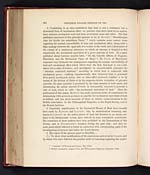Lord Kelvin (1824-1907)
On the dynamical theory of heat, with numerical results deduced from Mr Joule's equivalent of a thermal unit, and M. Regnault's Observations on steam.
262
PROFESSOR WILLIAM THOMSON ON THE
4. Considering it as thus established, that heat is not a substance, but a
dynamical form of mechanical effect, we perceive that there must be an equiva-
lence between mechanical work and heat, as between cause and effect. The first
published statement of this principle appears to be in MAYER's “ Bemerkungen
über die Kräfte der unbelebten Natur,”* which contains some correct views
regarding the mutual convertibility of heat and mechanical; effect, along with a
false analogy between the approach of a weight to the earth and a diminution of
the volume of a continuous substance, on which an attempt is founded to find
numerically the mechanical equivalent of a given quantity of heat. In a paper
published about fourteen months later, “On the Calorific Effects of Magneto-
Electricity and the Mechanical Value of Heat,Ӡ Mr JOULE of Manchester
expresses very distinctly the consequences regarding the mutual convertibility of
heat and mechanical effect which follow from the fact, that heat is not a sub-
stance but a state of motion; and investigates on unquestionable principles the
“absolute numerical relations,” according to which heat is connected with
mechanical power; verifying experimentally, that whenever heat is generated
from purely mechanical action, and no other effect produced, whether it be by
means of the friction of fluids or by the magneto-electric excitation of galvanic
currents, the same quantity is generated by the same amount of work spent, and
determining the actual amount of work, in foot-pounds, required to generate a
unit of heat, which he calls “the mechanical equivalent of heat.” Since the
publication of that paper, Mr JOULE has made numerous series of experiments for
determining with as much accuracy as possible the mechanical equivalent of heat
so defined, and has given accounts of them in various communications to the
British Association, to the Philosophical Magazine, to the Royal Society, and to
the French Institute.
5. Important contributions to the Dynamical Theory of Heat have recently
been made by RANKINE and CLAUSIUS; who, by mathematical reasoning ana-
logous to CARNOT's on the motive power of heat, but founded on an axiom con-
trary to his fundamental axiom, have arrived at some remarkable conclusions.
The researches of these authors have been published in the Transactions of this
Society, and in POGGENDORFF's Annalen, during the past year; and they are
more particularly referred to below in connection with corresponding parts of the
investigations at present laid before the Royal Society.
6. The object of the present paper is threefold,—
(1.) To shew what modifications of the conclusions arrived at by CARNOT, and
by others who have followed his peculiar mode of reasoning regarding the motive
* “Annalen” of WÖHLER and LIEBIG, May 1842.
† British Association, August 1843, and Philosophical Magazine, September 1843.


